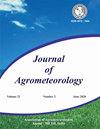Machine learning methods for estimating reference evapotranspiration
Q3 Agricultural and Biological Sciences
引用次数: 0
Abstract
Precise estimation of evapotranspiration is crucial for optimizing crop water uses particularly in the context of agriculture and horticultural production. In this study, various machine learning techniques was used to determine reference evapotranspiration by leveraging historical weather data. The models tested include artificial neural networks (ANN), Lasso, Ridge, Random Forest, LGBM regressor, and Gradient boosting regressor. LGBM regressor emerged as the top-performing model, exhibiting exceptional accuracy with a testing R-squared of 1.0. ANN also demonstrated notable performance, achieving a testing R-squared of 0.99. Moreover, the Random Forest and Gradient boosting regressor models showcased strong predictive capabilities, with R2 values of 0.99 and 0.98, respectively. These models offer valuable alternatives for estimating evapotranspiration, providing robustness and adaptability to diverse environmental datasets.估算参考蒸散量的机器学习方法
精确估算蒸散量对于优化作物用水至关重要,尤其是在农业和园艺生产中。本研究利用各种机器学习技术,通过历史气象数据确定参考蒸散量。测试的模型包括人工神经网络(ANN)、Lasso、Ridge、随机森林、LGBM 回归器和梯度提升回归器。LGBM 回归器成为表现最佳的模型,其测试 R 方为 1.0,表现出卓越的准确性。ANN 也表现突出,测试 R 方为 0.99。此外,随机森林和梯度提升回归模型也展示了强大的预测能力,R2 值分别为 0.99 和 0.98。这些模型为估算蒸散量提供了有价值的替代方法,具有稳健性和对不同环境数据集的适应性。
本文章由计算机程序翻译,如有差异,请以英文原文为准。
求助全文
约1分钟内获得全文
求助全文
来源期刊

Journal of Agrometeorology
农林科学-农艺学
CiteScore
1.40
自引率
0.00%
发文量
95
审稿时长
>12 weeks
期刊介绍:
The Journal of Agrometeorology (ISSN 0972-1665) , is a quarterly publication of Association of Agrometeorologists appearing in March, June, September and December. Since its beginning in 1999 till 2016, it was a half yearly publication appearing in June and December. In addition to regular issues, Association also brings out the special issues of the journal covering selected papers presented in seminar symposia organized by the Association.
 求助内容:
求助内容: 应助结果提醒方式:
应助结果提醒方式:


